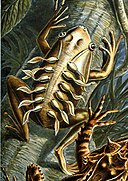Файл:Haeckel Batrachia.jpg
Перейти к навигации
Перейти к поиску

Размер этого предпросмотра: 424 × 599 пкс. Другие разрешения: 170 × 240 пкс | 339 × 480 пкс | 543 × 768 пкс | 724 × 1024 пкс | 2323 × 3284 пкс.
Исходный файл (2323 × 3284 пкс, размер файла: 2,17 Мб, MIME-тип: image/jpeg)
История файла
Нажмите на дату/время, чтобы посмотреть файл, который был загружен в тот момент.
| Дата/время | Миниатюра | Размеры | Участник | Примечание | |
|---|---|---|---|---|---|
| текущий | 03:17, 24 февраля 2006 |  | 2323 × 3284 (2,17 Мб) | Ragesoss | improve version, based on same original scan |
| 00:22, 11 февраля 2006 |  | 2318 × 3280 (2,21 Мб) | Ragesoss | The 68th plate from Ernst Haeckel's 1899 ''Kunstformen der Natur'', depicting frogs classified as Batrachia. Category:Ernst Haeckel |
Использование файла
Следующие 6 страниц используют этот файл:
Глобальное использование файла
Данный файл используется в следующих вики:
- Использование в arz.wikipedia.org
- Использование в ast.wikipedia.org
- Использование в az.wikipedia.org
- Использование в ban.wikipedia.org
- Использование в be.wikipedia.org
- Использование в bg.wikipedia.org
- Использование в ca.wikipedia.org
- Использование в ca.wikibooks.org
- Использование в ceb.wikipedia.org
- Использование в ckb.wikipedia.org
- Использование в dag.wikipedia.org
- Использование в de.wikipedia.org
- Использование в din.wikipedia.org
- Использование в el.wikipedia.org
- Использование в en.wikipedia.org
- Wikipedia:Featured pictures thumbs/04
- Wikipedia:Picture of the day/June 2006
- User:Ragesoss/Haeckel
- Wikipedia:Featured picture candidates/Haeckel Batrachia.jpg
- Wikipedia:Wikipedia Signpost/2006-03-13/Features and admins
- Wikipedia:Featured picture candidates/March-2006
- Talk:Frog/Archive 3
- User talk:Ragesoss/Archive1
- Wikipedia:Picture of the day/June 12, 2006
- Wikipedia:POTD/June 12, 2006
- Wikipedia:POTD column/June 12, 2006
- Wikipedia:POTD row/June 12, 2006
- Kunstformen der Natur
- User:Samsara/Frog/Stable
- User:RichardF/POTD
- Wikipedia:WikiProject Germany/Gallery
- User:Froggyyes~enwiki
- Wikipedia:Featured pictures/Animals/Amphibians
- Unclean spirit
- User:Xophist/s5
- Wikipedia:Wikipedia Signpost/2006-03-13/SPV
- Talk:Alfred Russel Wallace/Archive 1
- Portal:Amphibians/Selected picture
- User:The Transhumanist/Sandbox144
- Template:POTD/2006-06-12
Просмотреть глобальное использование этого файла.






